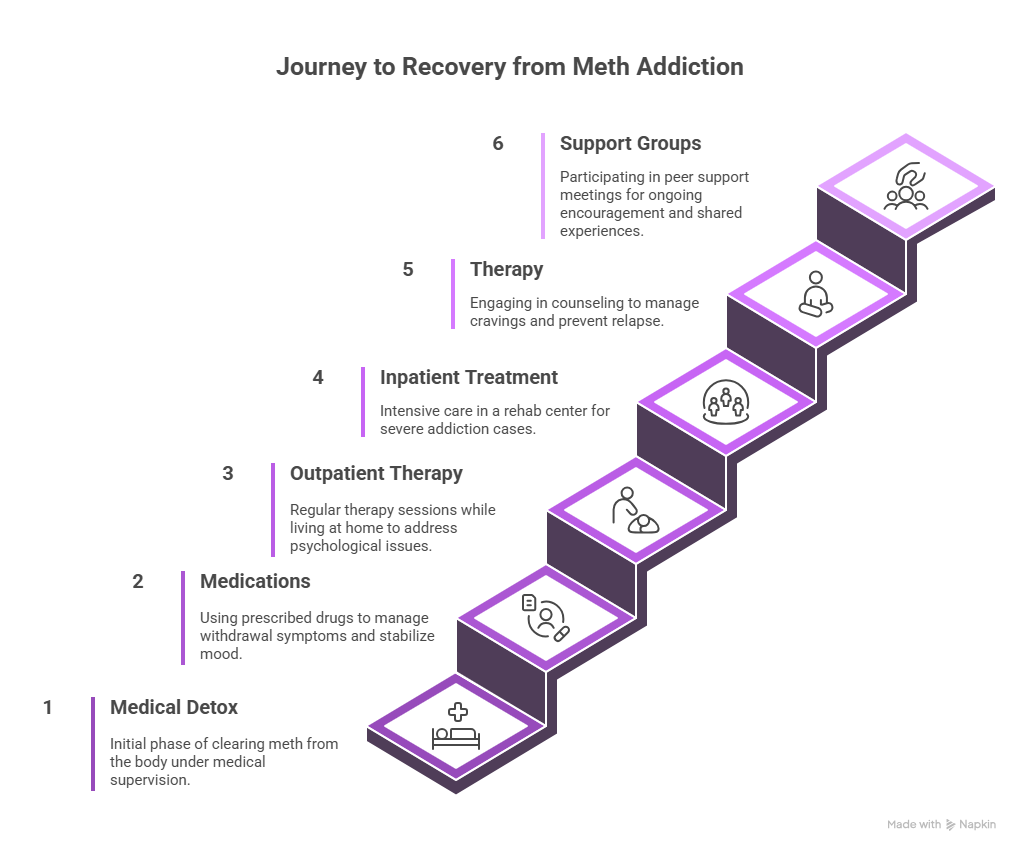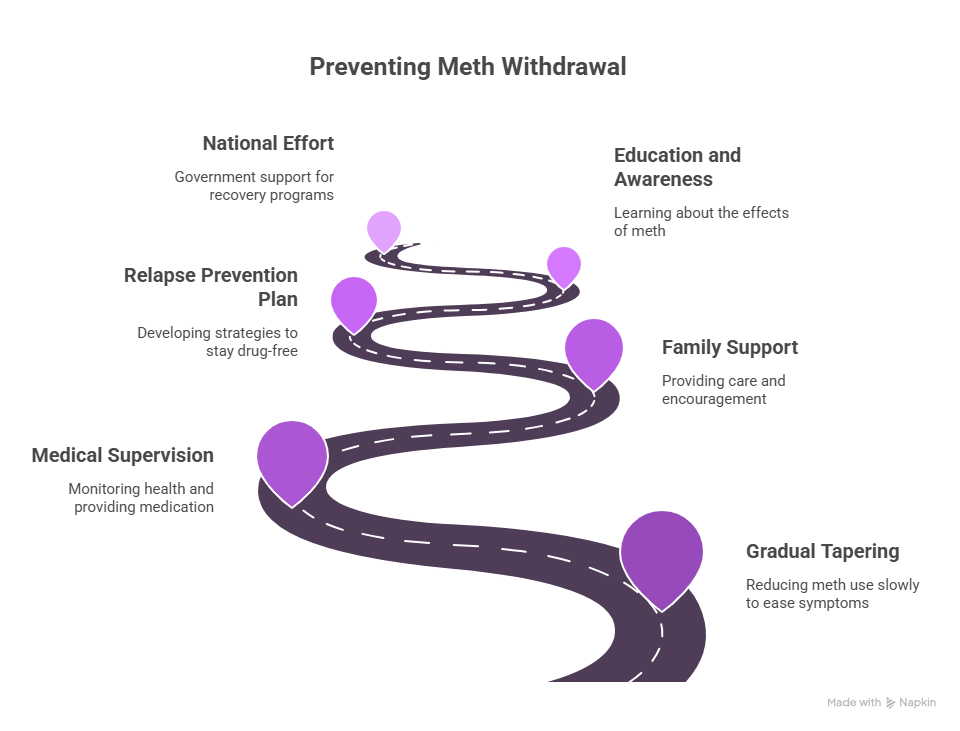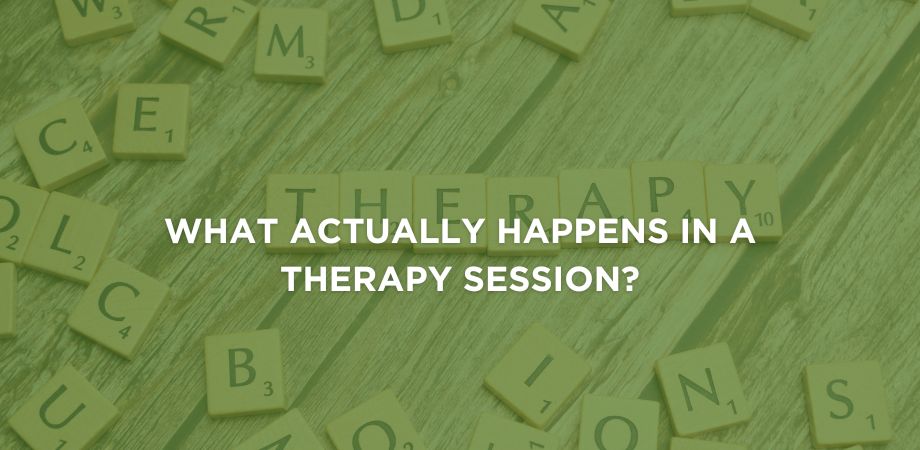Meth withdrawal involves physical and mental reactions that occur when a person with meth addiction or meth dependence stops using or reduces the drug. Meth is a shorthand for methamphetamine. Doctors describe methamphetamine withdrawal as part of substance use disorder (SUD), a condition listed in DSM-5 and recognised by the World Health Organisation.
The main causes of meth withdrawal are long-term meth use, increasing tolerance, and chemical imbalances in the brain. Methamphetamine (meth) affects the central nervous system (CNS) by lowering levels of dopamine and serotonin, two key brain chemicals linked to mood, sleep, and reward. When meth use ends, the brain has low levels of these chemicals and struggles to adjust, creating painful meth withdrawal symptoms.
The common withdrawal symptoms of meth withdrawal include fatigue, excessive sleep, appetite changes, tremors, anxiety, depression, irritability, and paranoia.
The timeline for methamphetamine withdrawal begins within 24 hours, peaks between 2-4 days, and symptoms improve over 5-10 days. Post-acute withdrawal symptoms (PAWS) last for 1-2 weeks, with cravings and mood problems.
The diagnosis of meth withdrawal involves clinical assessment, psychiatric evaluation, and urine drug tests conducted by a psychiatrist or addiction specialists.
The common treatment methods for meth withdrawal in India include detoxification, specialised meth inpatient rehab, outpatient therapy, counselling, cognitive behavioural therapy, medications such as antidepressants, antipsychotics, or benzodiazepines, and support in a medical detox centre in India and support groups like Narcotics Anonymous (NA).
The main risk factors of untreated meth withdrawal are relapse, overdose, suicide, and other comorbidities like depression, anxiety, or psychosis.
The main prevention strategies for meth withdrawal include relapse prevention, education and awareness and national efforts like Nasha Mukt Bharat Abhiyaan, run by the Ministry of Social Justice and Indian NGOs.
What Is Meth Withdrawal?
Meth withdrawal is a set of reactions that happen when someone with methamphetamine (meth) dependence stops or reduces meth use, says the National Institute on Drug Abuse (NIDA).
Doctors and the DSM-5 classify the withdrawal as meth withdrawal syndrome, which affects the central nervous system (CNS) and dopamine and serotonin levels in the brain.
Meth withdrawal results from physical dependence, where the body adapts to meth and requires it for normal functioning, and psychological dependence, where the brain develops intense cravings and urges to use meth.
What is the Difference Between Meth Withdrawal and Meth Detox?
The difference between meth withdrawal and meth detox is that meth withdrawal is the body and brain reactions when someone with methamphetamine use disorder (SUD) stops using meth. In contrast, meth detox is a supervised medical process that helps the body safely manage these withdrawal symptoms.
Meth withdrawal affects the central nervous system (CNS) and disrupts dopamine and serotonin levels, leading to a chemical imbalance. When meth use stops, the brain needs time to restore these chemicals, and during this period, one experiences withdrawal symptoms such as depression, fatigue, and tremors.
Meth detox involves a structured process at medical detox centres in India where psychiatrists or addiction specialists assist patients in safely stopping meth, reducing risk factors such as relapse and overdose, and providing counselling or therapy, sometimes with medications such as antidepressants to support rehabilitation and recovery.
The table below explains the difference between meth withdrawal and meth detox in a medical setting.
|
Meth Withdraw |
Meth Detox |
|
The body’s and brain’s reactions after stopping methamphetamine or reducing use |
Supervised medical process to safely manage meth withdrawal |
|
Happens naturally in the central nervous system (CNS), altering dopamine and serotonin levels in the brain |
Requires medical detox centre or hospital supervision with a psychiatrist or addiction specialists |
|
Symptoms include fatigue, anxiety, depression, irritability, paranoia |
Doctors use medications like antidepressants, antipsychotics, and Benzodiazepines, along with counselling and therapy, to ease symptoms |
|
Dangerous without medical support |
Safe with medical supervision, rehabilitation, and structured prevention strategies |
|
High risk factors such as relapse, overdose, suicidal thoughts, and worsening comorbidities like psychosis |
Low risk factors due to monitoring, structured care, and access to rehabilitation and recovery support |
What are the Causes of Meth Withdrawal?
The main causes of meth withdrawal are:
- Long-term meth use
- Increasing tolerance
- Brain chemical imbalance
The main causes of methamphetamine withdrawal are explained below.
- Long-term meth use occurs when a person repeatedly uses methamphetamine (meth) over weeks, months, or years. Ongoing meth use alters how the body responds to the drug, leading to physical and psychological dependence that causes withdrawal symptoms when methamphetamine use stops.
- Increasing tolerance occurs when the body becomes used to meth. The same dose produces fewer effects, so the person needs a higher amount. Rising tolerance strengthens drug dependence, making withdrawal more difficult.
- A brain chemical imbalance occurs when the brain does not have the correct levels of neurotransmitters, such as dopamine and serotonin. These chemicals regulate mood, reward, sleep, and motivation. Meth disrupts their balance, and when the drug stops, the brain lacks enough of these chemicals and struggles to adjust, causing physical and mental meth withdrawal symptoms such as depression and anxiety.
What Are the Symptoms of Meth Withdrawal?
The main symptoms of meth withdrawal are fatigue, anxiety, irritability, lack of energy, weight gain, dehydration, chills, insomnia, followed by hypersomnia, dysphoria, anhedonia, withdrawing from others, drug cravings, depression, mood swings, psychosis, suicidal thoughts, intense cravings for crystal meth, vivid, unpleasant dreams, agitation, paranoia, and trouble concentrating. Severe meth withdrawal causes extreme fatigue, severe depression, psychosis, and suicidal ideation.
The meth withdrawal symptoms are categorised into physical and psychological symptoms.
Physical Symptoms of Meth Withdrawal
The physical meth withdrawal symptoms are:
- Fatigue
- Lack of energy
- Weight gain
- Increased appetite
- Dehydration
- Chills
- Insomnia and hypersomnia
- Vivid, unpleasant dreams
- Exhaustion
- Excessive sleepiness
Psychological Symptoms of Meth Withdrawal
The psychological meth withdrawal symptoms are:
- Anxiety
- Irritability
- Mood swings
- Dysphoria (low mood)
- Depression
- Anhedonia (loss of ability to feel pleasure)
- Withdrawing from others
- Paranoia
- Drug cravings
- Trouble concentrating
- Suicidal thoughts/ideation
- Intense cravings for crystal meth
- Agitation followed by lethargy
- Severe depression
- Severe anxiety
- Psychosis
- Anhedonia
- Suicidal thoughts/ideation
- Strong drug cravings
The physical and psychological meth withdrawal symptoms are further divided into mild, moderate, and severe.
Mild Meth Withdrawal Symptoms
The mild meth withdrawal symptoms start within 24 hours after the last meth dose.
The mild meth withdrawal symptoms are:
- Fatigue
- Lack of energy
- Slight sleep changes
- Slight appetite changes
- Dehydration
- Anxiety
- Irritability
- Mild low mood
- Mood swings
- Withdrawing from others
The mild meth withdrawal symptoms are explained below.
- Fatigue is feeling very tired even without doing much.
- Lack of energy is when the body feels weak and daily tasks feel harder.
- Slight sleep changes are sleeping a little more or less than usual.
- Slight appetite changes are eating a little more or less than usual
- Dehydration is feeling very thirsty and dry in the mouth.
- Anxiety is feeling nervous or worried for no clear reason.
- Irritability is getting annoyed or upset easily.
- A mild low mood is feeling sad or down sometimes.
- Mood swings are feelings that change quickly, like from happy to sad.
- Withdrawing from others is ccwanting to be alone more than usual.
Moderate Meth Withdrawal Symptoms
The moderate meth withdrawal symptoms are:
- Chills
- Insomnia and hypersomnia
- Weight gain
- Increased appetite
- Vivid, unpleasant dreams
- Dysphoria
- Depression
- Anxiety
- Agitation followed by lethargy
- Trouble concentrating
- Paranoia
The moderate meth withdrawal symptoms are explained below.
- Chills is feeling cold and shivering even in warm places.
- Insomnia and hypersomnia is having trouble sleeping or sleeping too much.
- Weight gain refers to a rapid and noticeable increase in weight.
- An increased appetite is feeling hungry all the time.
- Vivid, unpleasant dreams are having bad or scary dreams during sleep.
- Dysphoria is feeling unhappy or empty for long periods.
- Depression is feeling very sad and hopeless.
- Anxiety is feeling nervous or panicked most of the time.
- Agitation followed by lethargy is feeling restless, then suddenly very tired.
- Trouble concentrating is difficulty focusing or thinking clearly.
- Paranoia is feeling like people are watching or judging you.
Severe Meth Withdrawal Symptoms
The severe meth withdrawal symptoms are:
- Extreme fatigue and excessive sleepiness
- Severe depression
- Severe anxiety
- Psychosis
- Anhedonia
- Suicidal thoughts/ideation
- Strong cravings for crystal meth
The severe meth withdrawal symptoms are explained below.
- Extreme fatigue and excessive sleepiness is being unable to stay awake or do activities.
- Severe depression is feeling deep sadness and hopelessness all day.
- Severe anxiety is feeling intense panic that doesn’t stop.
- Psychosis is seeing or hearing things that aren’t real.
- Anhedonia is the loss of all the ability to feel pleasure.
- Suicidal thoughts/ideation is thinking about harming yourself or ending your life.
- Strong cravings for crystal meth is feeling an intense need to use meth immediately.
What Are the Early Signs of Meth Withdrawal?
The early signs of meth withdrawal are:
- Feeling very tired or weak (fatigue)
- Trouble sleeping or sleeping too much
- Feeling nervous or worried (anxiety)
- Feeling easily annoyed or angry (irritability)
- Low mood or sadness (dysphoria)
- Strong cravings for meth
- Trouble focusing or thinking clearly
- Losing interest in things you usually enjoy (anhedonia)
- Withdrawing from friends or family
- Mild appetite changes (eating more or less than usual)

How Long Does Meth Withdrawal Last?
Meth withdrawal lasts for 1-4 weeks, with acute symptoms easing within 5-10 days and psychological issues such as lingering cravings, low mood, and anxiety lasting for more than a month.
The methamphetamine withdrawal timeline starts within 24 hours after the last meth dose, with symptoms like fatigue, irritability, and sleep problems appearing first. Symptoms typically peak 2-4 days after onset, then gradually improve over 5-10 days. Symptoms, such as mood swings, low motivation, and occasional cravings, continue for weeks.
Here’s a timeline of meth withdrawal showing how symptoms progress over the meth healing time.
- Early Withdrawal Stage: It starts within 24 hours after the last meth dose, with signs such as fatigue, irritability, anxiety, lack of energy, and trouble sleeping.
- Peak Withdrawal Stage: This is the most intense stage, starting 24-72 hours (1-3 days) after the last meth dose with symptoms such as strong cravings, depression, agitation, chills, vivid dreams and mood swings.
- Sub Acute Withdrawal Stage: It begins 4-10 days after stopping meth use, with symptoms such as intense cravings, depression, trouble concentrating, and low motivation starting to improve.
- Post Acute Withdrawal Stage (PAWS): It spans 1-2 weeks after quitting, with symptoms like lingering cravings, low mood, anxiety, anhedonia, and occasional sleep problems continuing.
The table below shows the progression of meth withdrawal symptoms over the 4 stages.
|
Stage |
Timeline |
Symptoms |
|
Early Withdrawal |
Starts within 12 hours after the last meth dose |
Fatigue, irritability, anxiety, lack of energy, trouble sleeping |
|
Peak Withdrawal |
Start 24-72 hours (1-3 days) after previous methamphetamine use |
Intense cravings, depression, agitation, chills, vivid dreams, mood swings |
|
Sub-Acute Withdrawal |
Starts 4-10 days after last dose |
Fatigue, weight changes, trouble concentrating, and depression start to improve |
|
Post-Acute Withdrawal Stage (PAWS) |
Starts 1-2 weeks after the last dose and continues for months for some symptoms, such as lingering cravings |
Lingering cravings, low mood, anxiety, anhedonia, occasional sleep problems |
How Do Doctors Diagnose Meth Withdrawal?
Doctors diagnose meth withdrawal through clinical assessment (checking your health), asking about meth use, and doing tests like urine checks.
Doctors’ meth withdrawal diagnosis steps and tools are explained below.
- Medical History Review: A medical history review, also known as a clinical assessment, is a process where doctors ask questions about your health and lifestyle habits. They’ll want to know how long you have used meth, how much and how often. They’ll ask about past illness or mental health problems, to help doctors understand how your body and mind are affected by meth.
- Physical Examination: A physical examination is a doctor’s comprehensive evaluation of your body for signs of stress or illness. They look at your heart rate, blood pressure, muscles, and nervous system. The results will show de-addiction doctors how meth affects your body and the central nervous system (CNS).
- DSM-5 Criteria Application: The DSM-5 is a guidebook that doctors use to list official symptoms of meth substance use problems and withdrawal. Doctors will use it to compare your symptoms to the rules to confirm meth withdrawal.
- Urine Drug Testing: This is a lab test that checks your urine for meth or its leftovers. It confirms recent use and makes sure symptoms are from meth, not other illnesses.
Using all these doctors’ steps and tools for diagnosing meth withdrawal reduces mistakes, which prevents misdiagnosis. The risks of misdiagnosis lead to patients receiving incorrect treatment and prolonging their meth recovery, risking their lives with severe meth withdrawal symptoms such as relapse or suicidal ideation.
What Are the Treatment Options for Meth Withdrawal?
The common treatment methods for meth addiction in India include medical detox, inpatient treatment programs, outpatient treatment, therapy, medications such as antidepressants, antipsychotics, or benzodiazepines, and support groups such as Narcotics Anonymous (NA).
The treatment options for methamphetamine withdrawal are explained below.
Medical Detox
Medical detoxification is a safe process in a de-addiction treatment centre, such as a rehab, clinic or hospital, where doctors help the body clear meth. This is the first step of meth treatment where doctors monitor vital signs, give fluids, and sometimes medicine to ease pain, cravings, or sleep.
Medications
Medications are drugs doctors give you to ease pain and discomfort from withdrawal symptoms, such as fatigue or depression. There are FDA-approved medications for the withdrawal, but doctors give you medications such as antidepressants, antipsychotics, or benzodiazepines to ease depression, anxiety or sleep problems during methamphetamine withdrawal.
Outpatient Treatment Program
Outpatient therapy is care given while you live at home, with regular visits for checkups, therapy, and medication support. It works best when you have mild meth symptoms and strong family support.
Inpatient Treatment Program
An inpatient treatment program is full-time care in a de-addiction rehabilitation centre or hospital, with close monitoring, therapy, and medical help. Inpatient rehab is best for severe meth addiction or someone with no safe home environment.
Therapy
Therapy is a counselling session, such as cognitive behavioural therapy (CBT), to help you manage cravings, stress, and risky/suicidal thoughts. Some de-addiction therapists include contingency management (reward systems for staying drug-free).
Support Groups
Support groups are peer groups or meetings like Narcotics Anonymous (NA), where you share your meth addiction experience and support each other’s meth recovery journey. The best meth de-addiction rehabilitation centres and support groups use the 12-step program. In this recovery method, people follow 12 spiritual and practical steps to stop using drugs and live a healthier life.
The 12 spiritual and practical steps include:
- Admitting you’re powerless over drugs and life has become hard to manage.
- Believe that a power greater than you will help restore you.
- Decide to turn your will and life over to that higher power.
- Take a deep and honest look at yourself.
- Admit your wrongs to yourself, your higher power, and to another person.
- Be ready to have your flaws and weaknesses removed.
- Humbly ask your higher power to remove those flaws.
- Make a list of people you harmed and be willing to make things right.
- Make direct amends to those people whenever possible, unless doing so would cause them further harm.
- Keep checking yourself, admit when you’re wrong, and fix it quickly.
- Seek to grow closer to your higher power through prayer and meditation.
- Share this message with others struggling and practice these steps in your daily life.
There are no home remedies that replace medical care for methamphetamine withdrawal. However, eating healthy food, staying hydrated, maintaining good sleep hygiene, and exercising can ease the symptoms.
What Are the Risks of Untreated Meth Withdrawal?
The common risks of untreated meth withdrawal are listed below.
- Relapse is going back to using meth after trying to stop. Meth cravings after withdrawal feel so strong that you often crave to use again if you have no support.
- Overdose is taking more doses of meth than before due to tolerance. Taking a bigger amount of meth than you used before, it overwhelms the body, causing an overdose.
- Suicidal thoughts are strong feelings of ending your life caused by profound sadness and hopelessness.
- Severe mental health issues are symptoms such as anxiety, paranoia (thinking people are against you), and psychosis (seeing or hearing things that aren’t real), which appear or get worse.
- Medical complications such as heart problems, dehydration, weight gain, or exhaustion harm your health if ignored.
- Isolation is the act of avoiding your family or friends. The loneliness makes it harder to cope and increases the risk.
- Treatment dropout is quitting recovery after just starting, because symptoms feel too hard. Leaving treatment early makes relapse and long-term harm more likely.
How to Prevent Meth Withdrawal?
To prevent meth withdrawal, consider the following safe steps.
- Gradual tapering is cutting down meth use little by little instead of stopping suddenly. This allows the brain and body to adjust, making symptoms such as fatigue, mood swings, and cravings more manageable.
- Medical supervision means addiction specialists and doctors watch your recovery in a clinic or detox centre. They’ll check your health to treat dangerous symptoms, such as depression, and give medications like antidepressants when needed.
- Family support involves loved ones providing care and encouragement during your withdrawal. It reduces loneliness, builds motivation, and makes it easier to avoid relapse.
- A relapse prevention plan is a set of tools from de-addiction therapists to stay drug-free. It teaches avoiding triggers, managing stress, and replacing meth use with healthier habits.
- Education and awareness are learning how meth harms the brain and body. Addiction awareness programs also guide families and communities on how to support drug recovery.
- The national effort is the government providing rehab and building community support around addiction recovery. In India, the Nasha Mukt Bharat Abhiyan program collaborates with NGOs to raise awareness, making recovery safer and connecting people to treatment more quickly.

What is the Difference Between Meth Dependence and Meth Addiction?
The main difference between meth dependence and meth addiction is that meth addiction is about the body’s physical need, while meth Addiction is about compulsive behaviour and loss of control.
Meth dependence happens when the brain and body get used to meth, so stopping causes withdrawal symptoms like fatigue, anxiety, or cravings. Addiction goes further. Meth addiction means you keep using meth even when it ruins your health, relationships, or work, and you feel powerless to stop.
Signs and symptoms of alcohol withdrawal syndrome
- Strong cravings for meth
- Needing larger amounts than before to feel the same high (tolerance)
- Withdrawal symptoms such as fatigue, anxiety or depression when not using
- Spending a lot of time thinking about getting, or using, meth
- Loss of control over how much or how often you use meth
- Failed attempt to cut down or cut meth use
- Using meth even when it ruins your health, relationships, work, or school
- Financial or legal problems related to meth use
What is the Difference Between Meth Withdrawal and Meth Overdose?
The main difference between meth withdrawal and meth overdose is that meth withdrawal happens when you stop using meth after a more extended time of use, while meth overdose happens when you take too much of meth.
Meth withdrawal is the body’s reaction to the absence of meth, causing fatigue, depression, cravings, and sleep problems. Meth overdose is taking too much meth at once, which overwhelms the body, causing chest pains, high blood pressure, seizures, stroke and even death.
When methamphetamine withdrawal is not life-threatening if appropriately managed, a meth overdose needs immediate emergency medical care to prevent fatal outcomes such as death.





